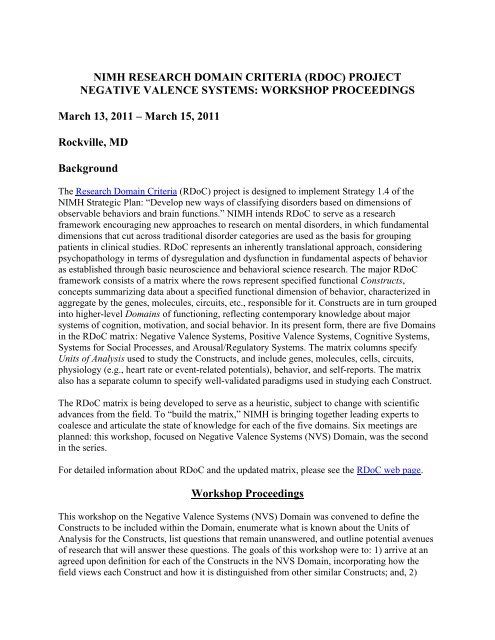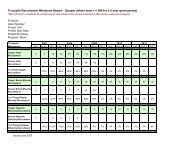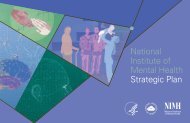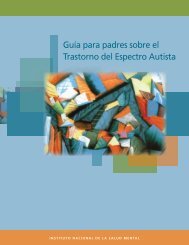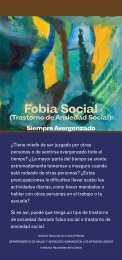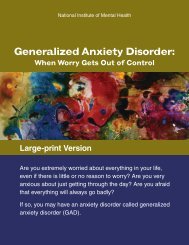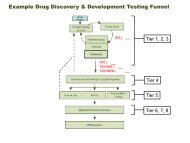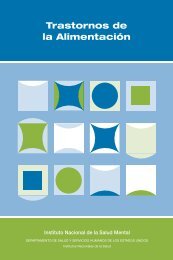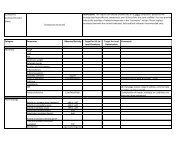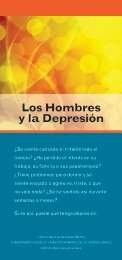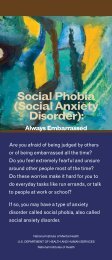NIMH RESEARCH DOMAIN CRITERIA (RDOC) PROJECT ...
NIMH RESEARCH DOMAIN CRITERIA (RDOC) PROJECT ...
NIMH RESEARCH DOMAIN CRITERIA (RDOC) PROJECT ...
You also want an ePaper? Increase the reach of your titles
YUMPU automatically turns print PDFs into web optimized ePapers that Google loves.
<strong>NIMH</strong> <strong>RESEARCH</strong> <strong>DOMAIN</strong> <strong>CRITERIA</strong> (<strong>RDOC</strong>) <strong>PROJECT</strong><br />
NEGATIVE VALENCE SYSTEMS: WORKSHOP PROCEEDINGS<br />
March 13, 2011 – March 15, 2011<br />
Rockville, MD<br />
Background<br />
The Research Domain Criteria (RDoC) project is designed to implement Strategy 1.4 of the<br />
<strong>NIMH</strong> Strategic Plan: “Develop new ways of classifying disorders based on dimensions of<br />
observable behaviors and brain functions.” <strong>NIMH</strong> intends RDoC to serve as a research<br />
framework encouraging new approaches to research on mental disorders, in which fundamental<br />
dimensions that cut across traditional disorder categories are used as the basis for grouping<br />
patients in clinical studies. RDoC represents an inherently translational approach, considering<br />
psychopathology in terms of dysregulation and dysfunction in fundamental aspects of behavior<br />
as established through basic neuroscience and behavioral science research. The major RDoC<br />
framework consists of a matrix where the rows represent specified functional Constructs,<br />
concepts summarizing data about a specified functional dimension of behavior, characterized in<br />
aggregate by the genes, molecules, circuits, etc., responsible for it. Constructs are in turn grouped<br />
into higher-level Domains of functioning, reflecting contemporary knowledge about major<br />
systems of cognition, motivation, and social behavior. In its present form, there are five Domains<br />
in the RDoC matrix: Negative Valence Systems, Positive Valence Systems, Cognitive Systems,<br />
Systems for Social Processes, and Arousal/Regulatory Systems. The matrix columns specify<br />
Units of Analysis used to study the Constructs, and include genes, molecules, cells, circuits,<br />
physiology (e.g., heart rate or event-related potentials), behavior, and self-reports. The matrix<br />
also has a separate column to specify well-validated paradigms used in studying each Construct.<br />
The RDoC matrix is being developed to serve as a heuristic, subject to change with scientific<br />
advances from the field. To “build the matrix,” <strong>NIMH</strong> is bringing together leading experts to<br />
coalesce and articulate the state of knowledge for each of the five domains. Six meetings are<br />
planned: this workshop, focused on Negative Valence Systems (NVS) Domain, was the second<br />
in the series.<br />
For detailed information about RDoC and the updated matrix, please see the RDoC web page.<br />
Workshop Proceedings<br />
This workshop on the Negative Valence Systems (NVS) Domain was convened to define the<br />
Constructs to be included within the Domain, enumerate what is known about the Units of<br />
Analysis for the Constructs, list questions that remain unanswered, and outline potential avenues<br />
of research that will answer these questions. The goals of this workshop were to: 1) arrive at an<br />
agreed upon definition for each of the Constructs in the NVS Domain, incorporating how the<br />
field views each Construct and how it is distinguished from other similar Constructs; and, 2)
provide an annotated listing (based on current knowledge) of the elements that would populate<br />
the RDoC matrix with respect to the genes, molecules, cells, circuits, physiology, and selfreports<br />
comprising each NVS Construct, as well as identify promising and reliable behavioral<br />
tasks that can be used to assess function within a Construct. The entries in the various Units of<br />
Analysis may be considered as priority elements for classifying research participants in clinical<br />
research grant applications.<br />
Preliminary Discussion<br />
The <strong>NIMH</strong> RDoC team had initially proposed three draft Constructs within the NVS Domain: fear,<br />
aggression, and distress. Based on each individual’s scientific expertise, the workshop participants<br />
were assigned to one of two “construct groups:” (1) fear and aggression, and (2) distress. Each<br />
group was first tasked with deciding whether their group’s Construct(s) needed to be revised from<br />
the original conception. Each group was split into two parallel breakout groups to facilitate<br />
discussion and encourage exploration of divergent opinions. Each breakout group was led by a<br />
moderator. Following breakout group meetings, the Construct groups (and then the entire group)<br />
would reassemble for further discussion and refinement of the products as necessary.<br />
The workshop generated a total of five Constructs under the NVS Domain. The definitions of<br />
these Constructs are provided below, followed by a summary of the discussions of the two<br />
Construct groups.<br />
Construct Definitions<br />
1. Responses to acute threat (Fear): Activation of the brain’s defensive<br />
motivational system to promote behaviors that protect the organism from<br />
perceived danger. Normal fear involves a pattern of adaptive responses to<br />
conditioned or unconditioned threat stimuli (exteroceptive or interoceptive). Fear<br />
can involve internal representations and cognitive processing, and can be<br />
modulated by a variety of factors.<br />
2. Responses to potential harm (Anxiety): Activation of a brain system in which harm<br />
may potentially occur but is distant, ambiguous, or low/uncertain in probability,<br />
characterized by a pattern of responses such as enhanced risk assessment (vigilance).<br />
These responses to low imminence threats are qualitatively different than the high<br />
imminence threat behaviors that characterize fear.<br />
3. Responses to sustained threat: An aversive emotional state caused by prolonged<br />
(i.e., weeks to months) exposure to internal and/or external condition(s), state(s),<br />
or stimuli that are adaptive to escape or avoid. The exposure may be actual or<br />
anticipated; the changes in affect, cognition, physiology, and behavior caused by<br />
sustained threat persist in the absence of the threat, and can be differentiated from<br />
those changes evoked by acute threat.
4. Frustrative non-reward: Reactions elicited in response to withdrawal/prevention<br />
of reward, i.e., by the inability to obtain positive rewards following repeated or<br />
sustained efforts.<br />
5. Loss: A state of deprivation of a motivationally significant con-specific, object, or<br />
situation. Loss may be social or non-social and may include permanent or<br />
sustained loss of shelter, behavioral control, status, loved ones, or relationships.<br />
The response to loss may be episodic (e.g., grief) or sustained.<br />
It is acknowledged that this list of NVS Constructs and definitions is not intended to be<br />
definitive or all-inclusive. It is expected that modifications will be made and additional<br />
Constructs will be added to the framework as science progresses. There are many<br />
possible Constructs that could have been included, notably social phenomena such as<br />
guilt, shame and disgust, which were not included because the workgroup was<br />
constrained to focus on Constructs that had the best fit with the stated criteria for<br />
Construct definition and the proposed units of measurement.<br />
Distinctions among Constructs:<br />
Acute threat is distinguished from potential harm by the immediacy and imminence of<br />
threat. Acute threat is considered to be a situation where the threat of harm is<br />
immediately present, or is impending in a matter of moments with a very high probability<br />
(e.g., as in fear conditioning). Potential harm, by contrast, is regarded as involving<br />
situations where danger might occur (e.g., dangerous contexts), but no immediate threat<br />
is present, thus requiring vigilance for threats of low or uncertain probability. While there<br />
is considerable overlap in the efferent activity generated, the distinction between these<br />
two constructs has found support in both animal and human literatures. In animal models,<br />
acute threat is associated with efferent activity from the amygdala, whereas potential<br />
harm has been shown to be related to activation of the bed nucleus of the stria terminalis<br />
(BNST).<br />
There was some uncertainty about whether responses to sustained threat should be<br />
considered as a separate Construct, or as variations in a temporal parameter of duration of<br />
threat that impact the circuits involved in acute threat and potential harm. Thus,<br />
activation of the hypothalamic-pituitary-adrenal (HPA) axis can result from a rather brief<br />
threat; however, when the same circuits are repeatedly activated over weeks to months,<br />
dysregulation in HPA axis activity and other systems can result in well-documented<br />
consequences. On the basis of certain changes in specific brain areas (e.g., the<br />
periventricular nucleus of the thalamus), the group provisionally decided to include<br />
sustained threat as a distinct Construct. However, further clarification is needed.<br />
In general, aggression was viewed as heterogeneous in terms of its antecedents,<br />
motivations, and expression/forms. Frustrative non-reward was seen as distinguished<br />
from other types of aggression:
• Defensive aggression is elicited by a real or perceived threat that leads to a pattern<br />
of behaviors directed at terminating the threat. As such, instances of defensive<br />
aggression could be considered to belong under the Responses to acute threat<br />
Construct.<br />
• Offensive (proactive) aggression is elicited by competition over resource<br />
acquisition or other positive consequences. This form of aggression often arises<br />
from differences in social status and dominance. As such, it will be considered in<br />
the Social Processes Domain RDoC Workshop.<br />
The group also discussed the phenomenon of learned helplessness (LH). While LH is an<br />
important paradigm that has generated much useful data, the majority agreed that it is not<br />
clear whether LH can be distinguished from a more general stress response in humans;<br />
thus, there is insufficient evidence currently to support LH as an independent Construct.<br />
SUMMARY OF CONSTRUCT GROUP DELIBERATIONS<br />
The material in the following sections is intended to provide background and context for<br />
the Construct definitions provided above. A variety of considerations and perspectives<br />
were discussed by the workshop participants; the set of Constructs and their definitions<br />
emerged from these valuable discussions.<br />
Definition Development<br />
Fear and Aggression Constructs Group<br />
Discussions related to the definition of fear considered general topics (e.g., defining a Construct<br />
as a normative state) and specific items (e.g., behavioral paradigms used to investigate fear in<br />
animals). The group agreed to limit the definition of the Construct to normative states, and to<br />
exclude from the definition abnormal presentations that may be considered pathological. In<br />
keeping with this approach, the participants discussed the Construct of fear from an evolutionary<br />
perspective, detailing the critical adaptive value of fear in normal function and survival. An<br />
additional dimension to be considered is the role of development in fear; however, the<br />
participants agreed that this would be an overarching theme for all RDoC Domains and<br />
Constructs and would not be appropriate for inclusion within the definition of a specific<br />
Construct.<br />
The participants discussed the diverse set of elicitors and presentations of fear, ranging from<br />
innate to conditioned fear stimuli and phasic or sustained fear. Additional complexity was added<br />
by discussing fear within a series of continuums, including imminence, severity, and<br />
characteristics of the threat. For instance, threatening stimuli can elicit fear responses; however<br />
these responses may be modulated by factors such as cognitive processing and prior experience,<br />
thus resulting in alterations that introduce related processes such as inhibition and/or extinction.<br />
Participants also discussed the role of the autonomic system and/or reflexive responses to a<br />
threatening stimulus; however the group concluded that this level of specificity may go beyond
the goals of a basic Construct definition for this stage of RDoC. Similarly, examples of fear<br />
behavioral responses were excluded from the definition.<br />
Emanating from the discussion of the RDoC definition of fear, the fear/aggression Construct<br />
group members were motivated to explore further an additional area that was identified: lowlevel<br />
threat response. Participants agreed that this anxiety-like concept would involve systems<br />
distinct from fear, and therefore decided that it would be an important and separate Construct<br />
within the NVS Domain; however, they did not agree on a title or descriptive term for this<br />
concept. As in the discussion of fear, the participants acknowledged overarching themes that<br />
would be applicable to this Construct, including evolutionary adaptability, developmental<br />
considerations, and sex differences. As indicated above, this Construct was included in the final<br />
set, and was termed “Responses to potential harm (anxiety).”<br />
For the general topic of aggression, the group considered the survey responses received by<br />
<strong>NIMH</strong> from the field prior to the workshop and agreed that aggression is best described as a<br />
behavior, and not necessarily a motivational state. A variety of motivations may lead to a similar<br />
set of behavioral presentations that encompass aggressive behavior. As such, participants<br />
discussed whether all forms of aggression would be appropriate for the NVS Domain. There was<br />
some discussion about creating a multi-faceted definition of aggression under the NVS Domain,<br />
with specific sub-definitions for three important and distinct forms of aggression (frustrative<br />
non-reward, offensive aggression, and defensive aggression) that may offer the potential for<br />
clarifying how different forms of aggressive behaviors are linked to distinct neural systems. The<br />
RDoC Working Group agreed with these distinctions, and decided that neither defensive<br />
aggression nor offensive (proactive) aggression met criteria for inclusion as an NVS Construct at<br />
this time; as outlined above (see “Distinctions among Constructs”), however, these latter two<br />
types of aggression were seen as appropriate to other parts of the RDoC Matrix. Empirical work<br />
might help to clarify or refine how aggression (and/or its component parts) may ultimately be<br />
best represented within the RDoC framework.<br />
Anger was identified as a motivational state that is often associated with aggression. However,<br />
the group determined that aggression does not necessarily require anger, and that anger as used<br />
in the literature may varyingly refer to any of the three aspects of “aggression” distinguished<br />
above; therefore, anger was excluded from the definition of frustrative non-reward. Similar to<br />
the discussion of fear, the participants acknowledged overarching themes that would be<br />
applicable to aggression, including evolutionary adaptability, developmental considerations, and<br />
sex differences.<br />
Populating the Elements within the Units of Analysis in the RDoC Matrix<br />
The preliminary RDoC matrix elements provided by the two fear/aggression breakout groups<br />
were largely overlapping and are displayed below. The group agreed that additional efforts<br />
should be targeted to develop better measures and self-report instruments. The group also agreed<br />
to include measures of brain activity (including neuroimaging), and the participants struggled<br />
with how best to represent and differentiate measures and tools while linking them to the RDoC<br />
matrix. One possibility would be to add a new Unit of Analysis to include these types of<br />
measures that do not seem well-suited to any of the six current Units of Analysis. However,<br />
there was no easy answer to account for the different methods and reliable tasks without making
unwieldy changes to the matrix. If an additional Unit of Analysis were to be included, perhaps<br />
some of the physiological measurements currently listed under “behavior” would be more suited<br />
to placement under the new Unit of Analysis. For the time being, approaches that loosely<br />
grouped tools with tasks or paradigms were included to ensure that this issue will eventually be<br />
resolved, possibly in ways that are consistent with other Constructs. As a result of this<br />
discussion, the RDoC Working Group added the “Paradigms” column to the RDoC matrix.<br />
Definition Development<br />
Distress Construct Group<br />
The charge to the distress group was somewhat different from that to the fear/aggression group<br />
because it was anticipated that, given the broad nature of the Construct, there would likely be a<br />
more prolonged discussion of the boundaries of the Construct and possible alternative or<br />
additional Constructs prior to generating a definition of the distress Construct. Indeed, both of<br />
the subgroups struggled with the “stress/distress” Construct because the concept was thought to<br />
be somewhat diffuse and it was difficult to precisely determine how it related to the other<br />
Constructs in the NVS Domain.<br />
Each of the two distress breakout groups found the proposed Construct to be vague and diffuse;<br />
as a result, instead of defining distress, both discussion groups independently generated similar<br />
ideas about re-organizing the NVS Domain as “responses to adversity” or “responses to stress,”<br />
with Constructs under the Domain reflecting a different type of adversity/stress (e.g., response to<br />
threat, response to loss). This re-organization was proposed because it could accommodate a<br />
wide range of experiences and situations that logically fall under the Construct. Adoption of this<br />
scheme, however, would require that the fear Construct, which was being addressed separately,<br />
be subsumed under this newly proposed Domain (fear being conceptualized as a response to<br />
threat). Rather than reorganize the entire Domain under a general heading of “adversity” or<br />
“stress,” the group instead focused on circuitry involved in responses to sustained adverse<br />
experiences. Thus, whereas fear could be considered a relatively acute and phasic phenomenon,<br />
when fear is elicited or experienced for a more prolonged time, it could be described as anxiety,<br />
and there is evidence that a different set of neural circuits are involved.<br />
There was some agreement that the stress Construct should capture the idea of a homeostatic<br />
comfort zone that is maintained via a three-stage process consisting of reaction, regulation and<br />
recovery. Activation of this three-stage process is often normative and adaptive, but can be<br />
disrupted in various ways (including hyperactivity and hypoactivity at one or more stages),<br />
resulting in different types and degrees of psychopathology. For example, worry or rumination<br />
could be conceptualized as resulting from a period of prolonged reactivity due to disruption of<br />
regulatory processes. In contrast to the fear Construct, where discussion focused on a relatively<br />
brief time frame of minutes to hours, distress was considered to have a longer time frame,<br />
including lifespan trajectories characterized by early adversity, followed by complex symptom<br />
presentations in adulthood. This sequential framework captures the temporal dynamics of<br />
emotional responding; the components could be studied from a developmental perspective. Some<br />
animal research paradigms and models are suitable for study of this type of extended distress.
Additionally, various coping processes, both adaptive and maladaptive, could be considered as<br />
part of this sequence.<br />
During breakout sessions and Construct group meetings, there were discussions of the possibility<br />
of having separate rows in the RDoC matrix for expression and modulation of each of the<br />
Constructs. Some regulatory processes might be specific to certain Constructs but others could<br />
be more general and reflect a response to a variety of different types of stress/adversity. There<br />
was some concern, however, that this might build in a level of specificity between processes and<br />
constructs for which there is currently insufficient empirical support. In addition, it was noted<br />
that the three stages (reaction, regulation and recovery) are not always easily dissociable and do<br />
not always occur strictly in that order. Rather than include these as separate elements in the<br />
matrix, investigators might consider the reaction-regulation-recovery sequence in their<br />
conceptualizations of RDoC-related research questions. However, it should be noted that this<br />
sequence would not be considered as forming the basis for experimental classifications per se.<br />
The workgroup discussed the many specific types of stress or adversity that could be expected to<br />
generate different but also overlapping responses (e.g., anxiety, worry, rumination, anhedonia,<br />
frustration, sadness, grief). There was some agreement that it was best to avoid having too high a<br />
degree of specificity. Instead, the goal was not to generate a comprehensive list of Constructs<br />
that accounts for all psychopathology but rather to generate a few Constructs that have wellcharacterized<br />
neural circuits, leaving room in the framework for the addition of other Constructs<br />
as the science progresses.<br />
The HPA axis generated considerable discussion both in the breakout group meetings and the<br />
general sessions. Although HPA axis activation was one of the most frequently nominated<br />
elements for the NVS matrix in a pre-workshop survey, workshop participants noted that HPA<br />
axis activation was insufficiently specific to negative valence: while the HPA axis can be<br />
activated in response to threat or stress, it can also be activated by positive valence salient stimuli<br />
or situations. The HPA axis can therefore be conceptualized as a modulatory system that is<br />
invoked by a variety of stimuli and situations and has a variety of effects on cognition (e.g.,<br />
cognitive control) and behavior (e.g., reward-seeking). There was some discussion of whether<br />
the HPA axis should be considered a neural circuit at all, as it is only partially embodied in the<br />
central nervous system. Activity of the HPA axis is, however, regulated by neural factors. HPA<br />
axis activity could be considered the consequence of a neural sequence, and is an important<br />
element of the reaction component in the reaction-regulation-recovery process. There was<br />
agreement that even though the HPA axis is activated by positive valence stimuli and situations,<br />
it remains an important element of the NVS Domain and should not be omitted. Workshop<br />
participants noted its importance with regards to endocrine function and suggested that it be<br />
included in the matrices for both the positive and negative valence systems.<br />
Sadness was the most frequently nominated Construct of the pre-workshop survey. The distress<br />
Construct group discussed sadness as a state that can be conceptualized as a response to loss,<br />
which is a specific type of adversity that is relatively well-characterized in the scientific<br />
literature. The group defined loss as the deprivation of a motivationally significant object or<br />
situation. It may be social or nonsocial and may include loss of food, shelter, behavioral control,<br />
status rewards, loved ones and relationships. The response to loss may be episodic, in which case<br />
it might be called grief, or sustained, in which case it might be called depression. Sadness is
evolutionarily conserved and can be studied in non-human primates as a behavior that has the<br />
evolutionary purpose of engaging the empathy and support of other members of the same<br />
species. Methods for studying loss in non-primate animals (e.g., analyzing distress vocalization<br />
following mother-separation) were discussed.<br />
Many pre-workshop survey respondents nominated anxiety as a Construct. Workshop<br />
participants discussed differentiating anxiety from fear based on the characteristics of the<br />
triggering cue, with fear occurring in response to a specific cue, and anxiety occurring in the<br />
absence of a specific cue, or in the presence of a sustained cue that is associated with negative<br />
stimuli with unpredictable onset latency.<br />
Another type of adversity that was discussed was blocked goal attainment, with the associated<br />
states of frustrative non-reward and learned helplessness (LH). Participants discussed how to<br />
elicit LH and how to measure the associated behavior in animals. Some participants suggested<br />
that the LH circuitry was well-defined in both humans and animals, but others felt that it is<br />
difficult to differentiate LH from a more general stress response in humans and that LH in itself<br />
is too narrow to constitute a Construct. There was some agreement that inability to attain reward<br />
and inability to avoid negative consequences would be included in the blocked goal attainment<br />
construct. As seen above, the term “frustrative non-reward” was chosen as the name for this<br />
Construct in the final set.<br />
Populating the Elements within the Units of Analysis in the RDoC Matrix<br />
Members of the distress Construct group noted that their discussion had been challenging and<br />
interesting and that this type of truly translational and integrative dialogue among basic and<br />
clinical investigators would not only move the RDoC initiative forward, but would benefit<br />
scientific progress. They described their process of identifying circuits that, although involved in<br />
many different Constructs, had unique inputs and outputs specific to a given Construct. It was<br />
noted that temporal factors are important, and although the structure of the matrix does not allow<br />
an explicit incorporation of time course, it will be important for investigators to consider<br />
temporal dynamics and granularity in experimental hypotheses and methods.<br />
As the group progressed with identification of circuits associated with the proposed Constructs,<br />
participants noted that some circuits seemed to be more general (e.g., amygdala involvement in<br />
reactivity, ventromedial and dorsomedial lateral prefrontal cortex in modulation or regulatory<br />
processes), with some shared variance. Nonetheless, there are a few well-defined circuits for<br />
specific behaviors (e.g., periaqueductal gray and escape).<br />
When identifying behaviors related to Constructs, participants agreed on the importance of<br />
considering not only what organisms do when they are stressed/facing adversity, but also what<br />
behaviors they do not perform well anymore as a result of being stressed/facing adversity (e.g.,<br />
disrupted cognition and over-reliance on habits).<br />
For the task of filling in the matrix elements, the group focused on loss, responses to sustained<br />
threat, and frustrative non-reward. The group did not focus on identifying self-report measures<br />
for these Constructs, because there was some agreement that although there are many existing<br />
self-report tools that address negative affective states such as depression and anxiety, these
measures are heavily oriented toward the DSM diagnostic system and vary in the quality of their<br />
psychometrics. The group chose to focus on other Units of Analysis and noted that future<br />
research efforts should be directed at modifying existing measures and developing novel selfreport<br />
tools focused on the RDoC Constructs.<br />
<strong>NIMH</strong> encourages comments on any aspect of the workshop and the proceedings outlined here.<br />
Please send comments to: rdoc@mail.nih.gov.<br />
Participants<br />
D. Caroline Blanchard, PhD, University of Hawaii at Manoa<br />
Richard J. Davidson, PhD, University of Wisconsin-Madison<br />
Michael Davis, PhD, Emory University<br />
Michael S. Fanselow, PhD, University of California, Los Angeles<br />
Michael First, MD, Columbia University<br />
Julie L. Fudge, MD, University of Rochester Medical Center<br />
Jill M. Goldstein, PhD, Harvard Medical School<br />
Ian H. Gotlib, PhD, Stanford University<br />
Christian Grillon, PhD, <strong>NIMH</strong> Division of Intramural Research Programs<br />
Wendy Heller, PhD, University of Illinois at Urbana Champaign<br />
James P. Herman, PhD, University of Cincinnati<br />
Elizabeth A. Kensinger, PhD, Boston College<br />
Daniel N. Klein, PhD, Stony Brook University<br />
Benjamin B. Lahey, PhD, University of Chicago<br />
Peter J. Lang, PhD, University of Florida<br />
Francis Lee, MD, PhD, Weill Medical College of Cornell University<br />
Ellen Leibenluft, MD, <strong>NIMH</strong> Division of Intramural Research Programs<br />
Joan Luby, MD, Washington University School of Medicine<br />
Steven F. Maier, PhD, University of Colorado at Boulder<br />
Stephen Maren, PhD, University of Michigan at Ann Arbor<br />
Helen S. Mayberg, MD, Emory University School of Medicine<br />
Marie-H. Monfils, PhD, University of Texas at Austin<br />
Christopher S. Monk, PhD, University of Michigan at Ann Arbor<br />
Betsy Murray, PhD, <strong>NIMH</strong>, Division of Intramural Research Programs<br />
Alies Muskin, Anxiety Disorders Association of America<br />
Bunmi O. Olatunji, PhD, Vanderbilt University<br />
Christopher Patrick, PhD, Florida State University<br />
Luiz Pessoa, PhD, University of Maryland, College Park<br />
Elizabeth A. Phelps, PhD, New York University<br />
Gregory J. Quirk, PhD, University of Puerto Rico<br />
Scott L. Rauch, MD, Mclean Hospital<br />
Kerry J. Ressler, MD, PhD, Howard Hughes Medical Institute, Emory University<br />
Anantha Shekhar, MD, PhD, Indiana University School of Medicine<br />
Greg J. Siegle, PhD, University of Pittsburgh School of Medicine<br />
H. Blair Simpson, MD, PhD, New York State Psychiatric Institute<br />
Mark Smith, MD, AstraZeneca Pharmaceuticals<br />
Margaret W. Sullivan, PhD, UMDNJ-Robert Wood Johnson Medical School
Regina M. Sullivan, PhD, New York University School of Medicine<br />
Paul J. Whalen, PhD, Dartmouth College<br />
Bruce Cuthbert, PhD<br />
Marjorie Garvey, MB, BCh<br />
Robert Heinssen, PhD<br />
Michael Kozak, PhD<br />
Sarah Morris, PhD<br />
Daniel Pine, MD<br />
Kevin Quinn, PhD<br />
Charles Sanislow, PhD, Wesleyan University<br />
Rebecca Steiner, PhD<br />
Phil Wang, MD, DrPH<br />
Kathy Anderson, PhD<br />
Shelli Avenevoli, PhD<br />
Susan Borja, PhD<br />
Alice Luo Clayton, PhD<br />
Rebecca Del Carmen, PhD (NICHD/<strong>NIMH</strong>)<br />
Jovier Evans, PhD<br />
Holly Garriock, PhD<br />
Mi Hillefors, MD, PhD<br />
Scherri Jacobsen<br />
Douglas Meinecke, PhD<br />
Peter Muehrer, PhD<br />
George Niederehe, PhD<br />
Molly Oliveri, PhD<br />
Michelle Pearson<br />
Andrew Rossi, PhD<br />
Mercedes Rubio, PhD<br />
Janine Simmons, MD, PhD<br />
Jane Steinberg, PhD<br />
Ann Wagner, PhD<br />
Julia Zehr, PhD<br />
<strong>NIMH</strong> RDoC Working Group Members<br />
<strong>NIMH</strong> Staff in attendance
Negative Valence Systems Matrix Specifications<br />
– – – – – – – – – – – UNITS OF ANALYSIS – – – – – – – – – – –<br />
G
CONSTRUCT: SUSTAINED THREAT<br />
Genes Molecules Cells Circuits Physiology Behavior Self-Reports Paradigms<br />
See reference:<br />
Heim JAMA<br />
article<br />
Decreased<br />
prefrontal and<br />
hippocampal<br />
arborization;<br />
Increased<br />
microglia<br />
Dysregulation of<br />
amygdala<br />
reactivity;<br />
Dysregulation of<br />
cingulate<br />
reactivity;<br />
Attention<br />
network (per<br />
Corbetta and<br />
Schulman);<br />
PVT<br />
(differentiates<br />
between acute<br />
and sustained);<br />
Hypothalamic<br />
nuclei;<br />
Habit systems<br />
(Striatum/caudat<br />
e/accumbens);<br />
Increased<br />
activation of<br />
vigilance<br />
network<br />
including visual<br />
cortex<br />
Dysregulated<br />
HPA axis;<br />
Increased<br />
amplitude of<br />
error-related<br />
negativity;<br />
Anxious<br />
arousal;<br />
Increased<br />
conflict<br />
detection;<br />
Attentional bias<br />
to threat;<br />
Anhedonia/decr<br />
eased appetitive<br />
behavior;<br />
Helplessness<br />
behavior;<br />
Decreased<br />
libido;<br />
Punishment<br />
sensitivity;<br />
Increased<br />
perseverative<br />
behavior;<br />
Avoidance;<br />
Memory<br />
retrieval deficits
CONSTRUCT: FRUSTRATIVE NON-REWARD<br />
MAOA,<br />
COMT,<br />
DAT1,<br />
5HTTR,<br />
5HTRs<br />
Genes Molecules Cells Circuits Physiology Behavior Self-Reports Paradigms<br />
Glutamate,<br />
Dopamine,<br />
Serotonin, GABA,<br />
Vasopressin,<br />
steroids<br />
Septum, PAG,<br />
amygdala,<br />
hypothalamus,<br />
OFC,<br />
striatum,<br />
parasympathetic<br />
system,<br />
LC<br />
physical and<br />
relational<br />
aggression,<br />
Proactive/<br />
reactive<br />
aggression<br />
questionnaire,<br />
Buss-Durkee and<br />
Buss Perry<br />
Physical and<br />
relational<br />
aggression<br />
paradigms,<br />
resident/human<br />
intruder test,<br />
PSAP, social<br />
dominance test
CONSTRUCT: LOSS<br />
Genes Molecules Cells Circuits Physiology Behavior Self-Reports Paradigms<br />
Downregulation<br />
of glucocorticoid<br />
receptors;<br />
Upregulation of<br />
CRH;<br />
Estrogens;<br />
Androgens;<br />
Oxytocin;<br />
Vasopressin;<br />
Inflammatory<br />
molecules<br />
Sustained<br />
amygdala<br />
reactivity;<br />
Decreased DLPFC<br />
recruitment;<br />
Decreased vmPFC<br />
(incl. rostral<br />
cingulate);<br />
Increased insula<br />
activation;<br />
Increased<br />
posterior<br />
cingulate activity;<br />
Decreased R<br />
parietal;<br />
PVN;<br />
Hippocampus;<br />
Orbitofrontal<br />
cortex;<br />
Habit systems<br />
(striatum/caudat<br />
e/accumbens);<br />
Increased default<br />
mode activity;<br />
Dysregulated<br />
reward circuitry<br />
ANS & HPA &<br />
neuroimmune<br />
dysregulation;<br />
Prolonged<br />
psychophysiolo<br />
gical reactivity<br />
Rumination;<br />
Withdrawal;<br />
Worry; Crying;<br />
Sadness; Lossrelevant<br />
recall<br />
bias;<br />
Attentional bias<br />
to negative<br />
valenced<br />
information;<br />
Guilt; Morbid<br />
Thoughts;<br />
Psychomotor<br />
retardation;<br />
Anhedonia;<br />
Increased selffocus;<br />
Deficits in<br />
executive<br />
function (e.g.,<br />
impaired<br />
sustained<br />
attention);<br />
Loss of drive<br />
(sleep, appetite);<br />
Decreased<br />
libido; shame;<br />
Amotivation;<br />
Memory<br />
impairments;<br />
Intrusive<br />
thoughts.<br />
Change in<br />
attributional<br />
style;<br />
Hopelessness


